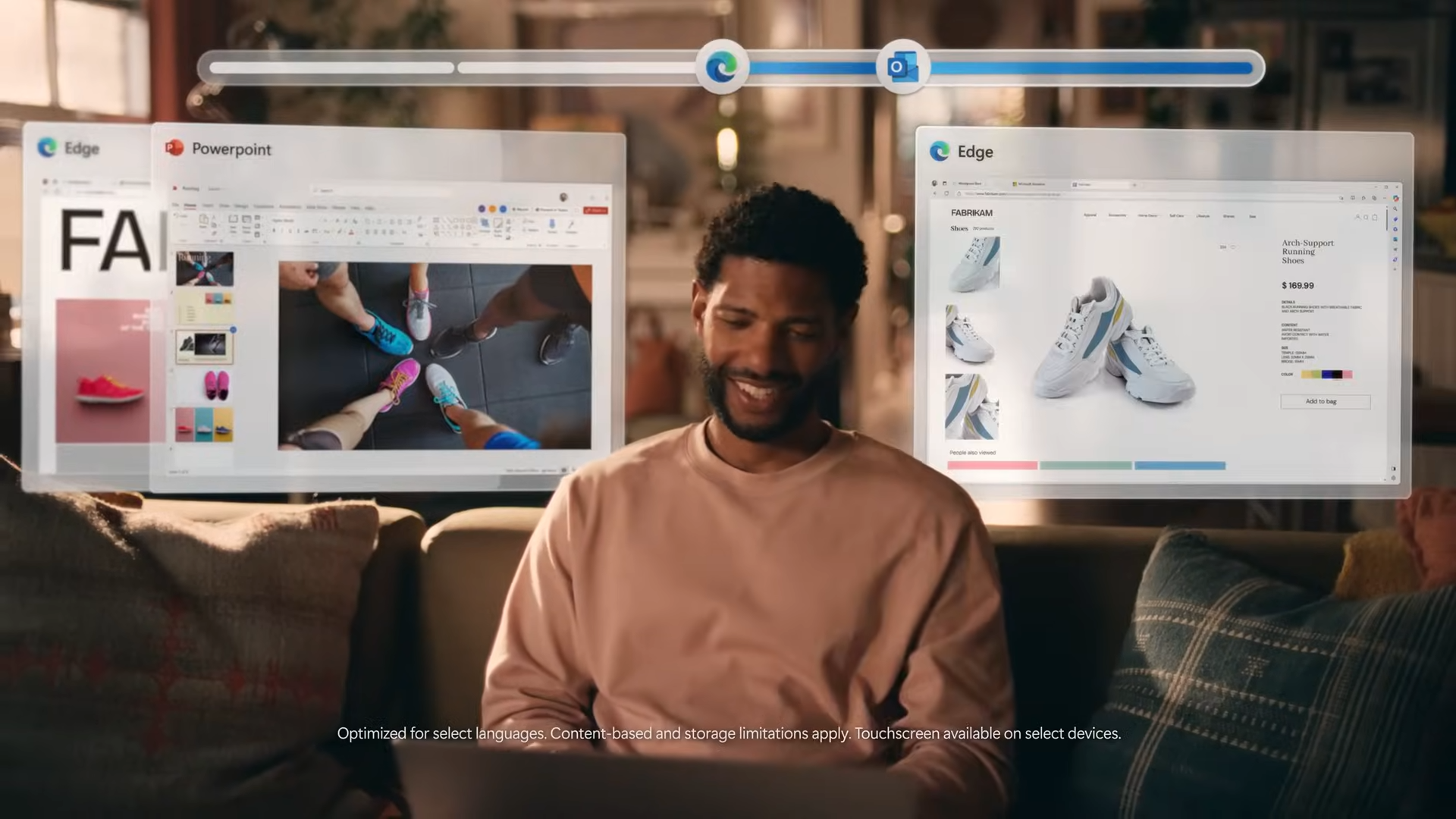Laptop Mag Verdict
The 2018 MacBook Pro 13-inch is super fast and the keyboard is improved, but the battery life could be better.
Pros
- +
Blazing overall performance
- +
Fastest SSD ever in a laptop
- +
Quieter (and more durable) keyboard
- +
Hey Siri' support built in
- +
Great Retina Display gets True Tone
- +
Awesome speakers
Cons
- -
Graphics performance falls behind competition
- -
Battery life could be better
- -
No full-size USB or SD Card slot
- -
Expensive
Why you can trust Laptop Mag
Editor's Note: Check out our review of the 2019 13-inch MacBook Pro, which includes an updated keyboard.
As someone who's been working every day with a 2016 MacBook Pro -- and who is sick of seeing spinning beach balls during heavy multitasking -- I'm happy to report that the 2018 MacBook Pro 13-inch with Touch Bar (starting at $1,799) has the serious speed boost I've been waiting for.
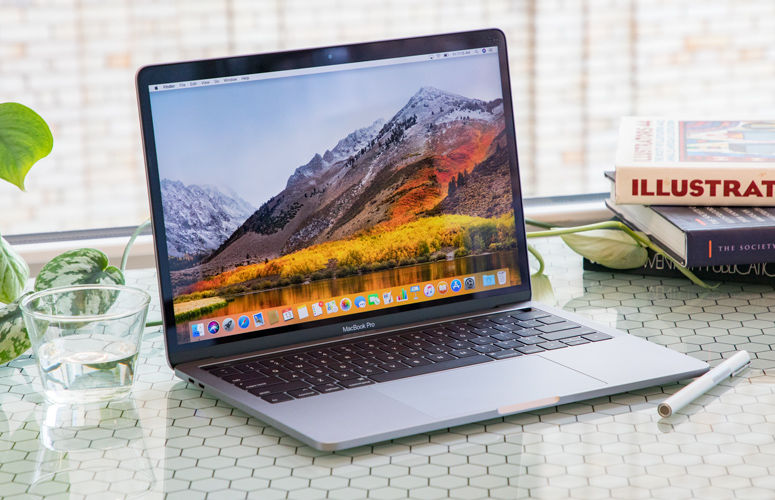
In fact, the 8th-gen Core i7 processor, 16GB of RAM, and 512GB SSD in my $2,499 configuration is probably overkill. But I don't care, because this thing is screaming fast. We're talking the fastest SSD ever in a laptop, plus some other benchmark scores that put some -- though not all -- Windows laptops to shame.
In other ways, this 2018 MacBook Pro is a subtle upgrade, including a quieter keyboard, "Hey Siri" support and a True Tone display. Overall, the 2018 MacBook Pro 13-inch feels fast, but it's battery life falls short of the longest lasting laptops.
See how the MacBook Pro stacks up against other Apple laptops in our MacBook Pro vs MacBook vs MacBook Air face-off.
Design: Solid but no longer sleek
The MacBook Pro 13-inch has an identical design to its predecessor, which is good and bad. On the positive side, the aluminum design still feels solid, and the Touch ID button makes it a cinch to log in with a touch of your finger. The speakers still sound rich and full, too, with no distortion at top volume.
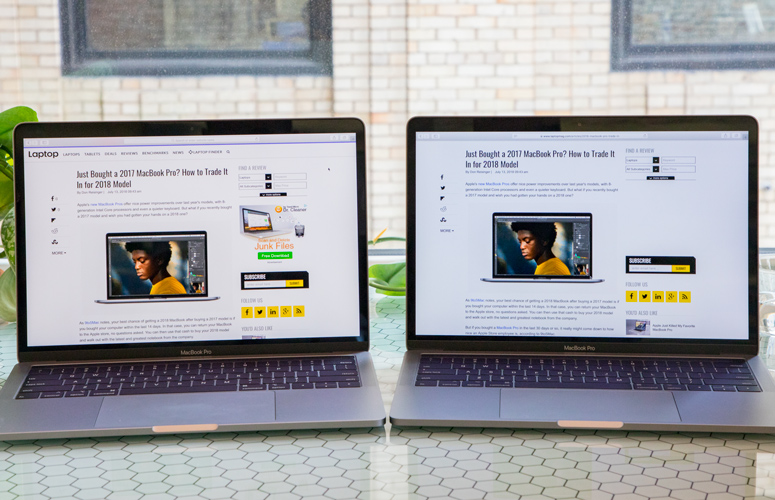
But as other notebook makers have slimmed down their wares, Apple's machine feels on the heavy side. And the bezels around the display are thicker than I'd like, especially toward the top.
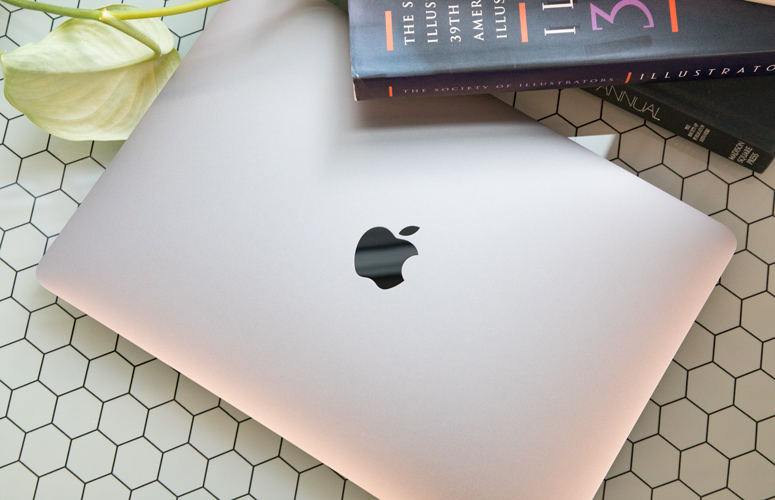
I'd also like Apple to add some more color options to the MacBook Pro. You get Silver or Space Gray. No cool white, like on the Dell XPS 13 or HP Spectre 13, or any other hues.
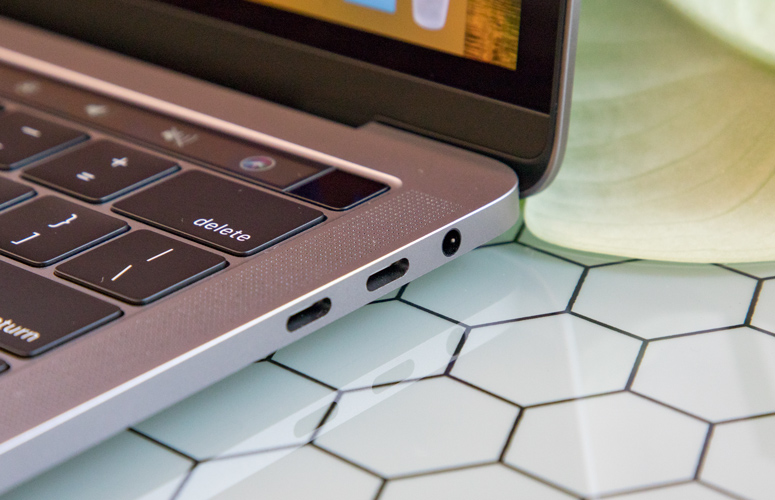
At 3.02 pounds and 12 x 8.4 x 0.6 inches, the 2018 MacBook Pro isn't as portable as I'd like. For example, the Dell XPS 13 is a lot more compact at 12 x 7.9 x 0.46 inches and significantly lighter at 2.65 pounds. The Huawei MateBook X Pro has a larger 14-inch screen and is still lighter than the 13-inch MacBook at 2.9 pounds.
Ports: Thunderbolt only
If you're looking for a full-size USB port or a microSD card slot, this is not the laptop for you. Apple continues to offer four Thunderbolt 3 ports on the 13-inch MacBook Pro with Touch Bar.
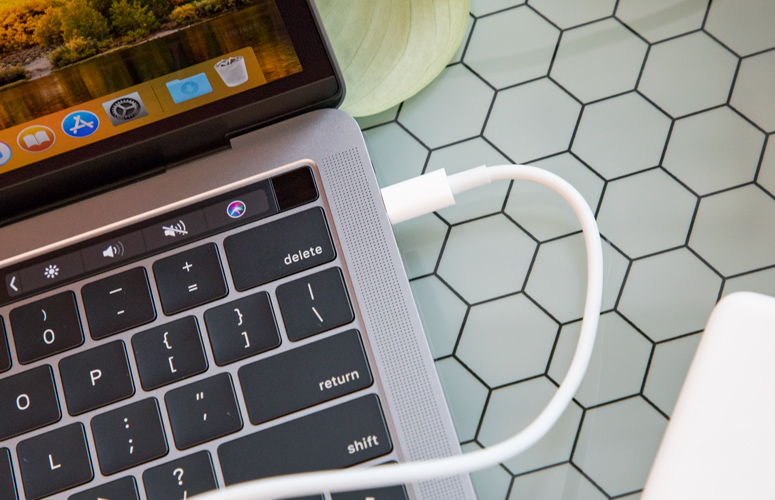
These ports offer blazing throughput and let you connect up to two 4K monitors at once. And, as Apple says, there are now 300 Thunderbolt 3 accessories in the market.
Keyboard: Quieter and (probably) more durable
The most controversial aspect of Apple's modern MacBook Pros has been its keyboards, and not just because they offer a shallow 0.55mm of travel. Some MacBook owners filed a class-action lawsuit over keyboard failures, while others have simply complained of stuck keys.
I have good news. Not only is the 2018 MacBook keyboard quieter, but it should be less susceptible to debris and stuck keys. I also find the layout a bit more comfortable than my older MacBook Pro.
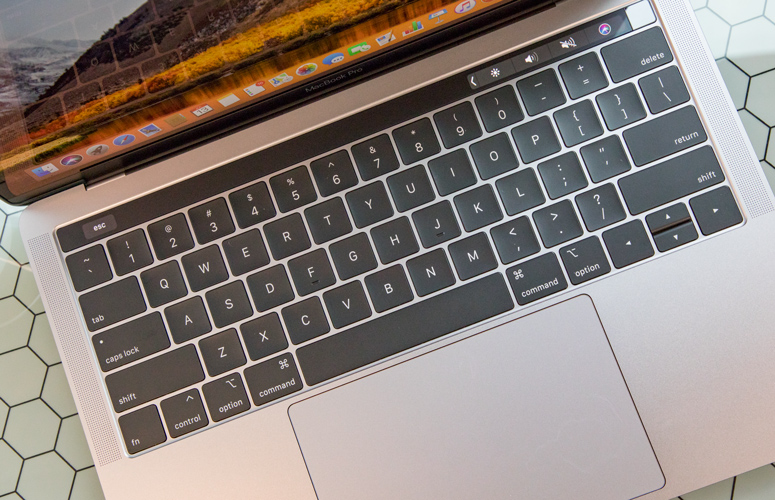
In side-by-side tests with my 2016 MacBook Pro, the keyboard on the 2018 model is indeed quieter. It also has a slightly softer feel than my current laptop, though I noticed less of a difference in both feel and volume between the 2017 MacBook Pro and the 2018 version.
Regardless, I typed quickly with few errors on the 10FastFingers typing test. I notched 72 words per minute with 97.6 percent accuracy. My best score on the 2016 MacBook Pro was 75 wpm but I made more errors, resulting in 93.8 percent accuracy.
A teardown by iFixit of the new MacBook Pro keyboard has discovered that Apple has employed a thin rubberized layer of silicone under its keycaps. This should prevent dust from getting into the keys and reduce the risk of sticky keys. A subsequent leak of Apple support documents seem to confirm that the new keyboards feature a thin, rubberized membrane layer under the keycaps.
In May 2019, Apple announced a brand new version of its Butterfly keyboard that promises to be more reliable. The improved keyboard is available on the 13-inch MacBook Pro with Touch Bar Now -- we'll update this review once we've gotten our hands on the new unit.
Display: TrueTone makes a difference
On the surface, the 13-inch display (2560 x 1600 pixels) on the 2018 MacBook Pro doesn't look any different, but with True Tone turned on, the screen is easier on the eyes. That's because the system leverages a dedicated sensor to dynamically change the whitepoint on the display to match the color temperature in the room.
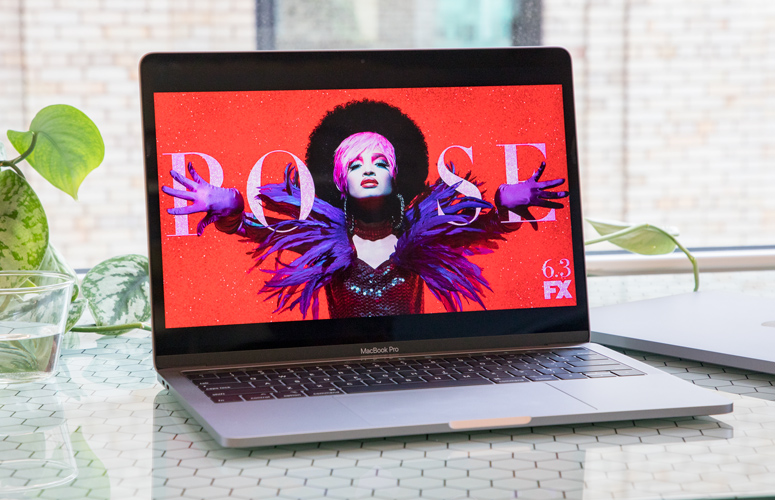
The result can be a more yellowish tint to things like Google Docs, but that actually makes for more comfortable viewing. You can always toggle this setting on or off in System Preferences if it proves distracting.
Otherwise, the Retina Display on this MacBook is just as good as its predecessor. When viewing a trailer for Pose on FX, I could make out every crevice in a character's lips during a close-up.
Based on our testing, this panel covers a good 119 percent of the sRGB color gamut. That's better than the Spectre 13 (111 percent), but the MateBook X Pro (124 percent) and XPS 13 (130 percent) scored higher.
Touch Bar: It works
The Touch Bar above the keyboard also gets the True Tone treatment to match the main display. This mini touchscreen (2170 x 60 pixels) does come in handy at times, such as for using music controls in the Spotify app, scrubbing through images with your finger in the photos app, and picking a favorite site to launch in Safari by touching its icon.
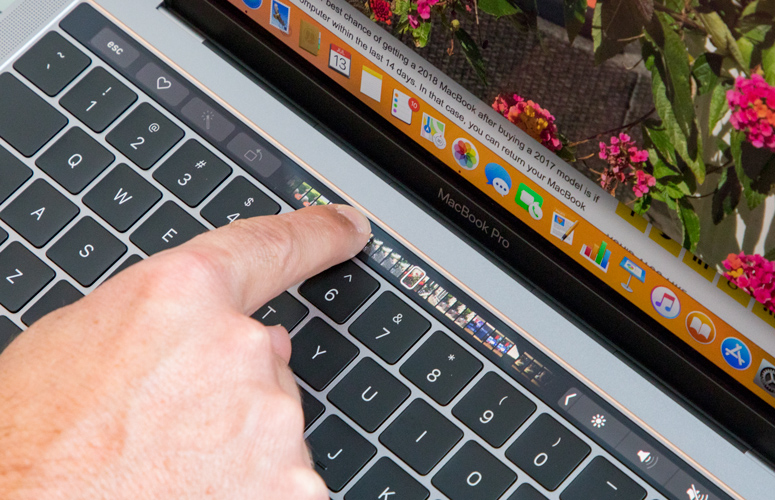
But a couple of years after Apple launched Touch Bar, I see this feature as nice to have and not a must-have. For what it's worth, though, this is the only feature on this $2,500 machine that made my kids "ooh" and "ah."
Performance: This is crazy fast
It's rare that I don't believe the results coming out of our lab, but in this case I had to do a double take. Based on our file copy test, which involves duplicating 4.97GB worth of files, the 2018 MacBook Pro has the fastest SSD I've ever seen in a laptop.
It took the system just 2 seconds to complete this task, which translates to 2,519 megabytes per second. Incredulous, we found another synthetic benchmark to test the SSD called BlackMagic Disk Speed Test. The result? An average write speed of 2,682 MBps.
The SSDs in competing Windows ultraportables are six times slower, with the otherwise speedy Dell XPS 13 offering 399.4 MBps and the average premium laptop hitting 279.3 MBps. The 256GB SSD in the Surface Laptop 2 turned in a low rate of 203 MBps.
With its 8th-gen, quad-core Core i7 processor and 16GB of RAM, the 13-inch MacBook Pro also smoked the competition on Geekbench 4, which measures overall performance. Apple's laptop scored 17,348. The next closest finisher, the XPS 13, notched 14,180, and the HP Spectre 13 (13,090) and the Huawei MateBook X Pro (12,913) were also far behind the MacBook Pro. The Surface Laptop 2 hit 12,676.
In terms of real-world performance, I haven't experienced any spinning balls so far in my testing, even as I've juggled 21 tabs in Chrome while I streamed Spotify in the background and used the Stride messaging app on the side.
MORE: Which Laptop CPU is Right for You?
The 13-inch MacBook Pro can handle demanding tasks well, too, such as transcoding a 4K video to 1080p using the Handbrake app. Apple's system took 14 minutes and 47 seconds to complete the task, which is more than 5 minutes faster than the premium laptop average and about 5 minutes faster than the 2017 MacBook Pro. The Dell XPS 13 hit 16 minutes even.
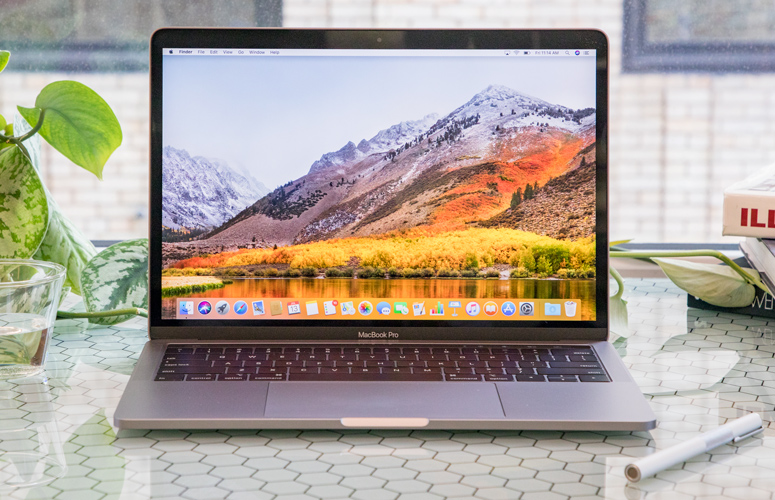
How about productivity? The 2018 MacBook Pro was neck and neck with its Windows cousins, taking 1 minute and 16 seconds to match 65,000 names and addresses in Excel. The XPS 13 was again faster at 1:08, as was the Asus ZenBook 13 (1:10), though the MateBook X Pro took a leisurely 1:49. The Surface Laptop 2 turned in a time of 1:15, which is similar to the MacBook Pro.
Graphics: Could be better
The one area where this MacBook Pro falls a bit flat is graphics. On the OpenGL portion of the Cinebench R15 benchmark, which measures graphics performance, the 2018 MacBook Pro 13-inch yielded 41.1 frames per second. The XPS 13 scored 49.3 fps on the same test.
On the Dirt 3 racing game, the MacBook Pro's Iris Plus Graphics 655 turned in a lame 46.9 frames per second on medium settings and 1600 x 1050 resolution. You can get a Windows laptop with more powerful Nvidia MX150 graphics -- like the MateBook X Pro and Asus ZenBook 13 - that delivers more than 110 fps. The Surface Laptop 2 with integrated graphics notched 82 fps.
T2 Chip: "Hey Siri" is here
"Hey, Siri. Skip track." ... "Hey, Siri. Open Safari to CNN.com." ... "Hey, Siri, lower the brightness." ... "Hey, Siri. Show me photos of my dog."
These are just a few of the commands I uttered during my testing, and Apple's assistant obliged. And I could do this all without touching the MacBook Pro, because of the new T2 chip inside. Yes, there's a Siri button on the Touch Bar, but you won't need to use it now. All you need to do is train the MacBook to learn your voice while setting up the laptop.
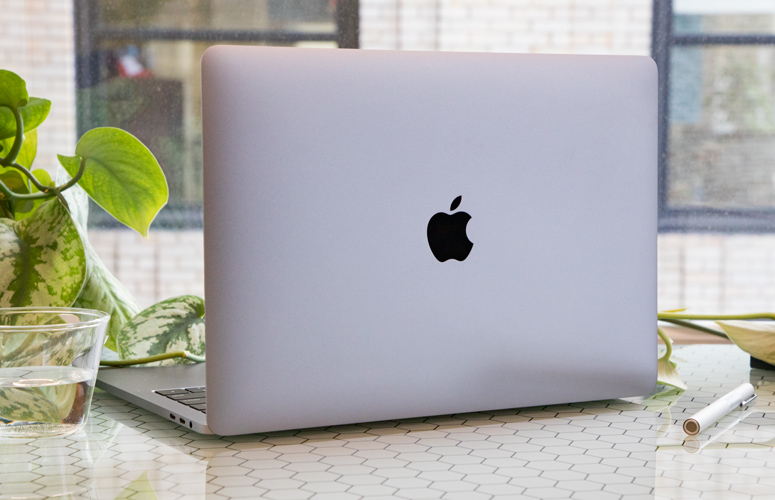
This is a pretty handy feature to have, and I can see myself using it often, especially for those queries that are specific to the notebook. But some commands I was hoping would work didn't. such as "Turn True Tone on." And if you have an iPhone, you'll want to turn Hey Siri so as not to activate your phone at the same time.
The T2 chip enables some other key features, including full disk encryption for data stored on the SSD and a secure boot process.
Battery Life: A bit above average
The MacBook Pro 13-inch offers better-than-average battery life, but other systems last longer. Our custom test replicates Web surfing over Wi-Fi on 150 nits of screen brightness. All of the pages are stored on a local server to ensure that Internet speeds don't play a role. The cotent includes streaming video, webGL anidations and stright text and graphics.
The MacBook Pro lasted 8 hours and 43 minutes on this test, which is a bit above the 8:21 average. but behind the MateBook X Pro (9:55), the Surface Book 2 (9:10) and Core i5 XPS 13 with 1080p Screen (12:37). The Surface Laptop 2 lasted 9:22, which also beats Apple's laptop. However, the 4K version of the XPS 13 lasted just 8:23. Last years's 13-inch Pro with a Core i5 CPU yielded 8:40 on a similar battery test.
MORE:Laptops with the Longest Battery Life
Heat: Or lack thereof
The 13-inch MacBook Pro's fan could get loud for a bit when I really pushed it, but it didn't run hot. On our heat test, which involves streaming a full HD video for 15 minutes and then measuring three different areas on the system, Apple's laptop kept fairly cool. The touchpad registered 86.5 degrees, and the area between the G and H keys hit 93.5 degrees. The underside only rached 92.5 degrees. All of these measurements are under our 95-degree comfort threshold.
MacBook Pro 2018 Price and Configurations: Bring money
The 13-inch MacBook Pro with TouchBar I reviewed starts at a steep $1,799 for a quad-core, 8th gen Core i5 processor, 8GB of RAM and 256GB of SSD storage. For $1,999, you can up the SSD to 512GB.
My (gulp) $2,499 configuration includes a Core i7 processor, 16GB of RAM and a 512GB SSD. Note that jumping from a Core i5 to Core i7 CPU costs $300, and it's $200 each for doubling the RAM from 8GB and the SSD storage from 256GB when configuring your own system.
Bottom Line
The 2018 13-inch MacBook Pro with Touch Bar is not a laptop for the masses, by dint of its price but also its power. But if you're a creative pro or power user who demands a laptop that's fairly portable, this system should mostly satisfy. The speed alone is great, and having Hey Siri on board proved more convenient than I thought it would. The quieter keyboard is also a welcome improvement. However, the battery life on this ultra-premium system isn't as long as some competing ultraportables.
Windows laptops like the XPS 13 have surpassed Apple with their sleeker and lighter designs, and you can get more powerful graphics for hundreds of dollars less in systems like the Huawei MateBook X Pro. Both of those laptops also last longer on a charge, as does the Surface Laptop 2, though Microsoft's system isn't as fast as Apple's. For this amount of dough, I also think Apple should offer a discrete GPU without requiring you to jump up to the 15-inch MacBook Pro.
Overall, if you're a macOS person, the new 13-inch MacBook Pro is a smarter and faster powerhouse.
Credit: Laptop Mag
Apple MacBook Pro 13-inch (2018, TB) Specs
| Bluetooth | Bluetooth 4.2 |
| Brand | Apple |
| CPU | Intel 8th-gen Core i7 |
| Company Website | https://www.apple.com/macbook-pro/ |
| Display Size | 13.3 |
| Graphics Card | Intel Iris Plus 655 |
| Hard Drive Size | 256GB SSD |
| Hard Drive Type | NVMe SSD |
| Highest Available Resolution | 2560 x 1600 |
| Native Resolution | 2560 x 1600 |
| Operating System | macOS Sierra |
| Ports (excluding USB) | Headphone, Thunderbolt 3 |
| RAM | 8GB |
| RAM Upgradable to | 16GB |
| Size | 12 x 8.4 x 0.6 inches |
| Touchpad Size | 5.3 x 3.3 inches |
| USB Ports | 4 |
| Video Memory | Shared |
| Warranty/Support | 90 days of complimentary technical support, 1-year limited warranty. |
| Weight | 3 pounds |
| Wi-Fi | 802.11 a/b/g/n/ac |

